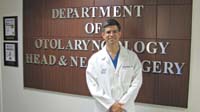|
By Dawn
Brazell
Public Relations
It's good that
M. Boyd Gillespie, M.D., loves
fishing — the patience of waiting
for just the right moment for a
trout to connect to his line, the
sudden rush of excitement when he
knows it's hooked.
It's a trait
that translates well to his
surgical work involving salivary
endoscopy, a delicate 'miniature'
surgery, using small instruments
to get into the tiny opening of
salivary glands to remove
blockages that can cause patients
swelling, discomfort and, in some
cases, infection. He sometimes
uses a tool called a basket
catcher to trap a stone that is
whirling around — a procedure not
totally unlike hooking a fish.
MUSC has become
a training center for salivary
endoscopy, a procedure that
originated about 10 years ago in
Germany, where the miniature
instruments were first introduced.
"I went to
Germany and became trained in
this. We acquired the equipment at
MUSC and have become the nation's
leader in this treatment. We're
currently the busiest endoscopic
salivary gland center in the
United States," he said. "Anytime
you have a service in your
department that has a national
reputation, it improves the
profile of your department."
Gillespie, an
otolaryngologist, has performed
more than 200 procedures since he
began doing salivary endoscopy at
MUSC in 2008. Patients have come
from across the nation — 16
different states — to have it
done. Often finding him via the
Internet, out-of-town patients
usually combine consulting with
him with a sight-seeing trip to
Charleston, he said.
MUSC also
serves as a training site for
salivary endoscopy with the
Department of Otolarygology having
provided training for 60 surgeons
from institutions such as Johns
Hopkins University to M.D.
Anderson Cancer Center. Hands-on
training in salivary endoscopy
will be held at MUSC, Oct. 21-22,
during the Head and Neck Oncology
Summit Meeting in Charleston.
Gillespie said
he's glad to see the technique's
use expand.
 Dr. M. Boyd
Gillespie has performed more
than 200 procedures since he
began doing salivary endoscopy
at MUSC in 2008. To see a video
about the procedure, visit http://tinyurl.com/3hnb6wr. Dr. M. Boyd
Gillespie has performed more
than 200 procedures since he
began doing salivary endoscopy
at MUSC in 2008. To see a video
about the procedure, visit http://tinyurl.com/3hnb6wr.
Previously the
only way to treat blockages in
these glands was to surgically
remove them, requiring an incision
on the face and neck in a
procedure that puts certain nerves
at risk. Salivary gland blockage
can result from multiple causes,
including salivary stones, scar
tissue, allergic disorders,
auto-immune diseases and as a
side-effect from certain
medications. The most common cause
of obstruction is salivary stones
that are thought to form from
mucous sludge, which becomes
mineralized with deposits of
calcium hydroxylapatite.
Blockages occur
in about 1 in 10,000 people a
year, which means about 30 cases a
year in Charleston. Open surgery
would be a two-to-three-hour
operation and one to two days in
the hospital, whereas the
endoscopy can be done in about an
hour as an outpatient treatment.
As long as a
stone isn't blocking a gland,
people can be asymptomatic, but
the stones tend to grow over time,
he said. Saliva has calcium in it,
which can deposit small grain-like
layers. People with dry mouth and
smokers seem to be more at risk to
develop stones. For patients who
do develop a blockage, it really
can affect their quality of life.
Gillespie, who
has provided keynote talks in this
area, said he's glad to see
advances being made as the
instrumentation evolves, including
a balloon-like device that will
help stretch and open ducts
similar to what's done with
angioplasty for the heart. The
ductal system is collapsible and
mobile, which means it takes
specialized training and precision
instruments for a surgeon to
navigate the bends and turns.
He likes
maintaining ties with colleagues
at the salivary center at
Erlangen-Nurnberg, Germany, with
whom he publishes papers. He
travels there in February to
assist with training, and their
center sends experts here for
training in the fall.
"It's a good
collaboration."
For more
information on the department,
visit http://www.muschealth.com/ent.
|



 Dr. M. Boyd
Gillespie has performed more
than 200 procedures since he
began doing salivary endoscopy
at MUSC in 2008. To see a video
about the procedure, visit
Dr. M. Boyd
Gillespie has performed more
than 200 procedures since he
began doing salivary endoscopy
at MUSC in 2008. To see a video
about the procedure, visit